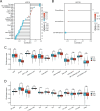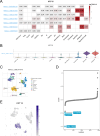The role of KRT18 in lung adenocarcinoma development: integrative bioinformatics and experimental validation
- PMID: 39729139
- PMCID: PMC11680526
- DOI: 10.1007/s12672-024-01728-0
The role of KRT18 in lung adenocarcinoma development: integrative bioinformatics and experimental validation
Abstract
Lung adenocarcinoma (LUAD) represents one of the most common subtypes of lung cancer with high rates of incidence and mortality, which contributes to substantial health and economic demand across the globe. Treatment today mainly consists of surgery, radiotherapy, and chemotherapy, but their efficacy in advanced stages is often suboptimal and emphasizes the clear need for new biomarkers and therapeutic targets. Using comprehensive bioinformatics analyses consisting of the Cancer Genome Atlas (TCGA), Gene Expression Omnibus (GEO), Human Protein Atlas (HPA) and Clinical Proteomic Tumor Analysis Consortium (CPTAC), immune infiltration analysis and functional enrichment analysis, and single-cell analysis, we examined the potential of keratin 18 (KRT18) as a candidate biomarker in advanced LUAD. KRT18 was significantly elevated in LUAD tissue relative to normal adjacent tissue (p < 0.05), and its expression was correlated with poor clinical-pathological features and inferior prognostic outcome. Furthermore, KRT18 expression was associated with several populations of immune cells, suggesting KRT18 may contribute to the local tumor microenvironment and potentially pathways of immune evasion. Survival analysis indicated that elevated KRT18 expression correlated with poor overall survival (OS), disease-specific survival (DSS), and progression-free interval (PFI), reinforcing its legitimacy as a prognostic tool (AUC = 0.846). Importantly, gene enrichment analysis found KRT18-associated genes enriched for pathways associated with lymphocyte differentiation and immune response pathways, which provides mechanistic insight into biological effects attributed to KRT18. Notably, NU.1025 has demonstrated the capability of reversing KRT18-modulated oncogenic features, and targeted therapeutic strategies can be developed moving forward. In conclusion, our data demonstrate that KRT18 has utility as a potential biomarker but may also serve as a therapeutic target in LUAD and merit further investigation into underlying mechanistic functions and potential therapeutic roles in the clinic.
Keywords: Biomarker; Immune microenvironment; Keratin 18; Lung adenocarcinoma; Prognosis; Targeted therapy.
© 2024. The Author(s).
Conflict of interest statement
Declarations. Ethics approval and consent to participate: Not applicable. Competing interests: The authors declare no competing interests.
Figures








Similar articles
-
AUNIP Expression Is Correlated With Immune Infiltration and Is a Candidate Diagnostic and Prognostic Biomarker for Hepatocellular Carcinoma and Lung Adenocarcinoma.Front Oncol. 2020 Dec 9;10:590006. doi: 10.3389/fonc.2020.590006. eCollection 2020. Front Oncol. 2020. PMID: 33363020 Free PMC article.
-
Identification of KRT80 as a Novel Prognostic and Predictive Biomarker of Human Lung Adenocarcinoma via Bioinformatics Approaches.Comb Chem High Throughput Screen. 2024 Jun 20. doi: 10.2174/0113862073294339240603103623. Online ahead of print. Comb Chem High Throughput Screen. 2024. PMID: 38910478
-
Bioinformatic prediction of miR-320a as a potential negative regulator of CDGSH iron-sulfur domain 2 (CISD2), involved in lung adenocarcinoma bone metastasis via MYC activation, and associated with tumor immune infiltration.Transl Cancer Res. 2024 Aug 31;13(8):4485-4499. doi: 10.21037/tcr-24-1188. Epub 2024 Aug 27. Transl Cancer Res. 2024. PMID: 39262456 Free PMC article.
-
High Expression of DLGAP5 Indicates Poor Prognosis and Immunotherapy in Lung Adenocarcinoma and Promotes Proliferation through Regulation of the Cell Cycle.Dis Markers. 2023 Jan 19;2023:9292536. doi: 10.1155/2023/9292536. eCollection 2023. Dis Markers. 2023. PMID: 36712920 Free PMC article.
-
Identification of CDT1 as a prognostic marker in human lung adenocarcinoma using bioinformatics approaches.PeerJ. 2023 Sep 28;11:e16166. doi: 10.7717/peerj.16166. eCollection 2023. PeerJ. 2023. PMID: 37790630 Free PMC article.
References
-
- Shi P, Li Z, Zhang Y, Shen C, Xia Q, Cao C, et al. Surgery or radiotherapy improves survival in elderly patients with early non-small cell lung cancer: a population-based analysis. J Can Res Ther. 2024;20(4):1251–7. 10.4103/jcrt.jcrt_973_23. - PubMed
-
- Watanabe S, Yotsukura M, Miyoshi T, Hattori A, Isaka T, Maniwa T, et al. Updated review of perioperative treatment for non-small-cell lung cancer in the new era of immune checkpoint inhibitors: past, present, and future. Jpn J Clin Oncol. 2024. 10.1093/jjco/hyae106. - PubMed
-
- Huet C, Basse C, Knetki-Wroblewska M, Chilczuk P, Bonte PE, Cyrille S, et al. Outcomes analysis of patients receiving local ablative therapy for oligoprogressive metastatic NSCLC under first-line immunotherapy. Clin Lung Cancer. 2024. 10.1016/j.cllc.2024.07.009. - PubMed
Grants and funding
LinkOut - more resources
Full Text Sources
Research Materials
Miscellaneous
